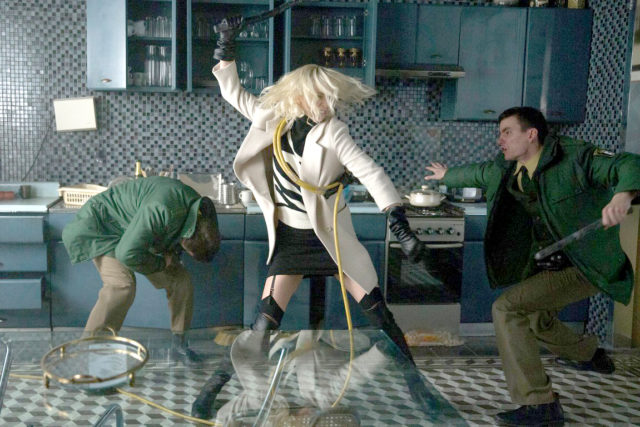
With apologies to SNL’s Cecily Strong, during its first 40 minutes, Atomic Blonde is “the person you wish you hadn’t started a conversation with at a party.” Like someone who read talking points about the Cold War on Twitter and can’t wait to share them, the movie repeats big words it barely understands about complex international history to tell a story more confused than complicated. Then it shakes its head and says, “Sorry, I guess it’s all just too hard for you to understand. Hey, do you want to dance?” And then the dancing starts, everything is awesome and that’s all you’ll ever remember about the night.
Set right at the fall of the Berlin Wall, Atomic Blonde does the thing where it twists itself into a narrative pretzel right away to make itself seem more sophisticated. All it boils down to is (A) a spy gets killed, (B) he had a list with the real identities of tons of spies on both sides of the Cold War, (C) there’s a double agent and (D) MI-6 agent Lorraine Broughton (Charlize Theron) is dispatched to retrieve the list and find the identity of the double agent. This requires consorting with Douchey the Bro spy, David Percival (James McAvoy), and Frenchie the Lady spy, Delphine Lasalle (Sofia Boutella). Broughton sleeps with the latter and not the former, which is a wise move for many reasons.
The story is told backwards, with Broughton locked in a room with her boss (Toby Jones) and an American CIA higher-up (John Goodman) explaining “what had happened was…” Atomic Blonde is the kind of movie that thinks such a gimmicky device is sophisticated, like drinking a Bud Light Lime from a straw. In reality, the movie only succeeds because Theron plays a jaded, broken spy far better than Daniel Craig can and director David Leitch and cinematographer Jonathan Sela can shoot the living hell out of brutal fight scenes. And we’re talking brutal with a capital “Dear God, that man has a set of car keys dangling from a puncture wound in his face!”
Everything that Craig has labored to do in most of his James Bond movies, Theron effortlessly outmatches here. Not just in terms of the fight sequences, which are as ghastly as they are captivating, but in terms of character beats. Although shot with a camera placed squarely in the male gaze, when Broughton seduces the French operative — who would have been given a “boy’s club” punny name like “Oui-oui Menage-a-trois” in a 007 movie — Theron gives the relationship tragic gravity. When she sighs in lament of her bloodied past, it feels inherently authentic. So too does the “jukebox on speed” soundtrack that shuffles frantically through ’80s classics and German covers of those classics, exposing Baby Driver’s lauded track-list as downright juvenile.
What doesn’t feel authentic are the self-serious espionage subplots and obvious “twists” and reveals. Had Atomic Blonde sped up the pace of its glacial first hour, ditched the pseudo-intellectual bravado and focused on its lead and not the trappings surrounding her, it would have been an instant action-flick classic. Instead, it’s a mixed bag that proves the 007 franchise can be revitalized if the producers replace Bond with this blonde.
This review previously appeared in The Reader of Omaha, Nebraska.














